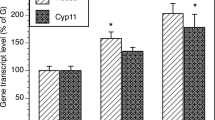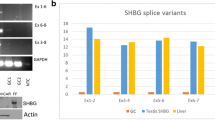Summary
Primary cultures of immature rat Sertoli cells in plastic dishes are highly responsive to follicle stimulating hormone (FSH) and its second messenger, cAMP, in metabolizing testosterone to estradiol, thus indicating the presence of an active, hormone-regulated aromatase cytochrome P450 (P450arom). However, in vivo studies indicated that P450arom is FSH-responsive only in very young animals, where the cells have not yet differentiated, but they lose this ability later on in development. Sertoli cells grown on Matrigel (a reconstituted basement membrane), laminin (a basement membrane component), or in bicameral chambers coated with Matrigel, assume structural and functional characteristics more similar to that of in vivo differentiated Sertoli cells. When the cells were cultured on laminin or Matrigel, the FSH- and cAMP-induced estradiol production was greatly reduced by 30 and 60%, respectively. When Sertoli cells were cultured in bicameral chambers coated with Matrigel, no induction of testosterone aromatization by FSH or cAMP was observed. However, FSH-induced cAMP formation was greater when the cells were cultured on basement membrane or in the chambers than on plastic dishes. These results suggest that culture conditions favoring the assumption by Sertoli cells of a phenotype closer that of the differentiated cells in vivo (tall columnar and highly polarized) suppress the induction of P450arom by FSH and cAMP. We then examined the mechanism(s) by which cell phenotype affects p450arom activity. Northern blot analyses of Sertoli cell RNA revealed one major band of 1.9 Kb and two minor bands of 3.3 and 5.2 Kb. However, there were no changes at the level of the expression of P450arom messenger RNA under the different culture conditions. No differences were found in P450arom enzymatic activity measured by the3H2O release method in microsomes prepared from Sertoli cells cultured under the various conditions. Similarly, no differences were observed in the amount of protein detected by immunoblot analysis of Sertoli cell extracts using an antiserum raised against the human placental enzyme. Recombination experiments using microsomes from cells cultured on plastic or in the chambers and cytosol from control or FSH-treated cells cultured on plastic also proved inadequate in inducing P450arom activity. These data suggest that: a) P450arom activity could be used as a specific marker for Sertoli cell differentiation, and b) the differentiation process in Sertoli cells is associated with specific changes in the microenvironment or the regulation of P450arom, or both, that rendered the enzyme insensitive to FSH or cAMP induction.
Similar content being viewed by others
References
Amri, I.; Al-Timimi, I.; Silberzahn, P. Inhibition of microsomal estrogen synthetase by cytosol in the equine corpus luteum. J. Steroid Biochem. 33:155–160; 1989.
Bisat, T.; Brown, T. R.; Migeon, C. J., et al. Influence of cell culture conditions on aromatase activity in human genital skin fibroblasts. In Vitro Cell. Dev. Biol. 25:806–812; 1989.
Burton, K. A study of the conditions and mechanism of the diphenylamine reaction for the colorimetric estimation of deoxyribonucleic acid. Biochem. J. 62:315–322; 1956.
Byers, S. W.; Hadley, M. A.; Djakiew, D., et al. Growth and characterization of polarized monolayers of epididymal epithelial cells and Sertoli cells in dual environment culture chambers. J. Androl. 7:59–68; 1986.
Cheng, C. Y.; Hornsby, P. J. Expression of 11β-hydroxylase and 21-hydroxylase in long-term cultures of bovine adrenocortical cells requires extracellular matrix factors. Endocrinology 130:2883–2889; 1992.
Chomczynski, P.; Sacchi, N. Single-step method of RNA isolation by acid guanidinum thiocyanate-phenol-chloroform extraction. Anal. Biochem. 162:156–159; 1987.
Dorrington, J. H.; Fritz, I. B.; Armstrong, D. T. Control of testicular estrogen synthesis. Biol. Reprod. 18:55–64; 1978.
Dym, M.; Lamsam-Casalotti, S.; Jia, M.-C., et al. Basement membrane increases G-protein levels and FSH responsiveness of Sertoli cell adenylyl cyclase. Endocrinology 128:1167–1176; 1991.
Epstein-Almong, R.; Orly, J. Inhibition of hormone-induced steroidogenesis during cell proliferation in serum-free cultures of rat granulosa cells. Endocrinology 116:2103–2112; 1985.
Gaillard, J. L. Equine testicular aromatase: substrate specificity and kinetic characteristics. Comp. Biochem. Physiol. 100B:107–115; 1991.
Gaillard, J-L.; Al-Timimi, I.; Quincey, D., et al. The equine testicular aromatase: substrates and inhibitors. J. Steroid Biochem. 36:123s; 1990.
Hadley, M. A.; Byers, S. W.; Suarez-Quian, C. A., et al. Extracellular matrix regulated Sertoli cell differentiation, testicular cord formation, and germ cell development in vitro. J. Cell Biol. 101:1511–1522; 1985.
Hadley, M. A.; Byers, S. W.; Suarez-Quian, C. A., et al. In vitro models of differentiated Sertoli cell structure and function. In Vitro Cell. Dev. Biol. 24:550–557; 1988.
Hickey, G. J.; Chen, S.; Besman, M. J., et al. Hormonal regulation, tissue distribution, and content of aromatase cytochrome P450 messenger ribonucleic acid and enzyme in rat ovarian follicles and corpora lutea: relationship to estradiol biosynthesis. Endocrinology 122:1426–1436; 1988.
Janecki, A.; Steinberger, A. Polarized Sertoli cell functions in a new two-compartment culture system. J. Androl. 7:69–71; 1986.
Kellis, J. T.; Vickery, L. E. Purification and characterization of human placental aromatase cytochrome P-450. J. Biol. Chem. 262:4413–4420; 1987.
Kleinman, H. K.; McGarvey, M. L.; Hassell, J. R., et al. Basement membrane complexes with biological activity. Biochemistry 25:312–318; 1986.
Laemmli, U. K. Cleavage of structural proteins during the assembly of the head of bacteriophage T4. Nature 227:680–685; 1970.
Mallea, L. E.; Machado, A. J.; Navaroli, F., et al. Epidermal growth factor stimulates lactate production and inhibits aromatization in cultured Sertoli cells from immature rats. Int. J. Androl. 9:201–208; 1986.
Maniatis, T.; Fritsch, E. F.; Sambrook, J. Molecular cloning, 2nd ed. Cold Spring Harbor, NY: Cold Spring Harbor Laboratory; 1989.
Mendelson, C. R.; Means, G. D.; Mahendroo, M. S., et al. Use of molecular probes to study regulation of aromatase cytochrome P-450. Biol. Reprod. 42:1–10; 1990.
Nakajin, S.; Shinoda, M.; Hall, P. F. Purification to homogeneity of aromatase from human placenta. Biochem. Biophys. Res. Commun. 134:704–710; 1986.
Nozu, K.; Dehejia, A.; Zawistowich, L., et al. Gonadotropin-induced receptor regulation and steroidogenic lesions in cultured Leydig cells. J. Biol. Chem. 258:12875–12882; 1981.
Onoda, M.; Suarez-Quian, C. A.; Djakiew, D., et al. Characterization of Sertoli cells cultured in bicameral chamber system: relationship between formation of permeability barriers and polarized secretion of transferrin. Biol. Reprod. 43:672–683; 1990.
Orly, J.; Sato, G.; Erickson, G. F. Serum suppresses the expression of hormonally induced functions in cultured granulosa cells. Cell 20:817–827; 1980.
Panayotou, G.; End, P.; Aumailley, M., et al. Domains of laminin with growth factor activity. Cell 56:93–101; 1989.
Papadopoulos, V.; Carreau, S.; Szerman-Joly, E., et al. Rat testis 17β-estradiol: identification by gas chromatography-mass spectrometry and age related cellular distribution. J. Steroid Biochem. 24:1211–1216; 1986.
Pomerantz, D. K. Effects ofin vivo gonadotropin treatment on estrogen levels in the testis of the immature rat. Biol. Reprod. 21:1247–1255; 1979.
Pomerantz, D. K. Developmental changes in the ability of follicle stimulating hormone to stimulate estrogen synthesisin vivo by the testis of the rat. Biol. Reprod. 23:948–954; 1980.
Pomerantz, D. K. Interactions of follicle-stimulating hormone and luteinizing hormone in controlling estradiol synthesis by the testis of the infant rat. Biol. Reprod. 28:890–896; 1983.
Payne, A. H.; Perkins, L. M.; Georgiou, M., et al. Intratesticular site of aromatase activity and possible function of testicular estradiol. Steroids 50:435–448; 1987.
Rommerts, F. F. G.; De Jong, F. H.; Brinkmann, A. O., et al. Developmental and cellular localization of rat testicular aromatase activity. J. Reprod. Fertil. 65:281–283; 1982.
Rosselli, M.; Skinner, M. K. Developmental regulation of Sertoli cell aromatase activity and plasminogen activator production by hormones, retinoids and the testicular paracrine factor, PModS. Biol. Reprod. 46:586–594; 1992.
Schuetz, E. G.; Li, D.; Omiecinski, C. J., et al. Regulation of gene expression in adult rat hepatocytes cultured on basement membrane matrix. J. Cell. Physiol. 134:309–323; 1988.
Smith, P. K.; Krohn, R. I.; Hermanson, G. T., et al. Measurement of protein using bicinchoninic acid. Anal. Biochem. 150:76–85; 1985.
Suarez-Quian, C. A.; Dym, M.; Makris, A., et al. Estrogen synthesis by immature rat Sertoli cells. J. Androl. 4:203–209; 1983.
Thompson, E. A.; Siiteri, P. K. Studies on the aromatization of C-19 androgens. Ann. NY Acad. Sci. 212:378–391; 1973.
Towbin, H.; Staehelin, T.; Gordon, J. Electrophoretic transfer of proteins from polyacrylamide gels to nitrocellulose sheets: procedure and some applications. Proc. Natl. Acad. Sci. USA 76:4350–4354; 1979.
Tsai-Morris, C. H.; Aquilano, D. R.; Dufau, M. L. Cellular localization of rat testicular aromatase activity during development. Endocrinology 116:38–46; 1985.
Valladares, L. E.; Payne, A. H. Effects of hCG and cyclic AMP on aromatization in purified Leydig cells of immature and mature rats. Biol. Reprod. 25:752–758; 1981.
Vukicevic, S.; Kleinman, H. K.; Luyten, F. P., et al. Identification of multiple active growth factors in basement membrane Matrigel suggests caution in interpretation of cellular activity related to extracellular matrix components. Exp. Cell Res. 202:1–8; 1992.
Author information
Authors and Affiliations
Rights and permissions
About this article
Cite this article
Papadopoulos, V., Jia, MC., Culty, M. et al. Rat Sertoli cell aromatase cytochrome P450: Regulation by cell culture conditions and relationship to the state of cell differentiation. In Vitro Cell Dev Biol - Animal 29, 943–949 (1993). https://doi.org/10.1007/BF02634233
Received:
Accepted:
Issue Date:
DOI: https://doi.org/10.1007/BF02634233




